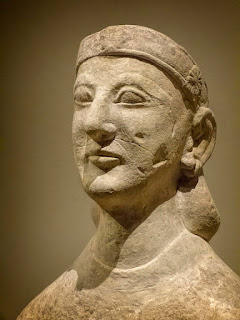The early documented history of Cyprus begins with an inscribed stele commemorating a victory by Sargon II (722–705 BCE) of Assyria there in 709 BCE. Assyrian domination of Cyprus appears to have begun earlier than this, though, during the reign of Tiglath-Pileser III (744–727 BCE), and ended with the fall of the Neo Assyrian Empire in 609 BCE, whereupon the city-kingdoms of Cyprus gained independence once more. Following a brief period of Egyptian domination in the sixth century BCE, Cyprus fell under Persian rule. Royal palaces excavated on Cyprus resemble the architecture of Achaemenid examples like Persepolis, with audience chambers, open courtyards, bathhouses, and stores. Town fortifications and houses were built of mudbrick walls on stone foundations.
Early Greek influence is reflected in Cypriot sculpture, however. Archaic Greek art with its attractive smile on the face of the statue is found on many ritual pieces dating between 525–475 BCE although portrait sculptures began to exhibit more realism. Ionian influence on sculptures intensified and copies of Greek korai appear, as well as statues of men in Greek dress. Naked kouroi, however, although common in Greece, are extremely rare in Cyprus, while women are always presented dressed with rich folds in their garments. The pottery in Cyprus retained its local influences, although some Greek pottery was imported at this time.
Cyprus supplied armies and ships for Persia's foreign campaigns including Xerses' invasion of Greece in 480 BCE where Cyprus contributed 150 ships to the expedition. Despite this, Cyprus took part in the Ionian Revolt in 499 BCE led by the brother of the king of Salamis. But the Persians crushed the Cypriot armies after a five-month siege.
However, when Evagoras I of Salamis dominated Cypriot politics for forty years, he favored Athens during the closing years of the Peloponnesian War, elicited Persian support for the Athenians against Sparta and urged Greeks from the Aegean to settle in Cyprus. At the beginning of the 4th century BCE, he took control of the whole island of Cyprus and within a few years was attempting to gain independence from Persia with Athenian help.
Following resistance from the kings of Kition, Amathus and Soli, who fled to the great king of Persia in 390 BC to request support, Evagoras received less help from the Athenians than he had hoped for and in about 380 BCE, a Persian force besieged Salamis and Evagoras was forced to surrender. In the end, though, he remained king of Salamis until he was murdered in 374 BCE, but only by accepting his role as a vassal of Persia. Together with Egypt and Phoenicia, Cyprus rebelled against Persian rule again in 350 BCE, but the uprising was crushed by Artaxerxes III in 344 BCE.
Cyprus finally gained political independence when, hearing of Alexander's great victory over the Persians at Issus, the Cypriots rose up against their Persian overlords yet again and made available to Alexander the fleet of ships formerly in the service of Persia. These ships and Cypriot engineers were instrumental in Alexander's successful siege of Tyre in 332 BCE.
When I saw these portraits of Cypriot men at the Metropolitan Museum of Art, I thought their faces reflected this independent nature.
 |
| Terracotta head of a man wearing a wreath Cypriot Late Classical 4th century BCE photographed at the Metropolitan Museum of Art |
 |
| Male Head Cypriot Hellenistic period 3rd-2nd centuries BCE Limestone photographed at the Legion of Honor Museum in San Francisco, California. |
 |
| Closeup of a limestone grave marker depicting men reclining at a banquet Cypriot Classical Period 4th century BCE photographed at the Metropolitan Museum of Art |
 |
| Limestone figure of a young beardless man of high rank probably in service to a deity Cypriot Archaic early 6th c. BCE photographed at the Metropolitan Museum of Art |
 |
| Closeup of limestone male figure in Egyptian dress Cypriot Archaic 3rd quarter of the 6th century BCE photographed at the Metropolitan Museum of Art |
 |
| Limestone head of a bearded man wearing a conical cap indicating high rank Cypriot Archaic early 6th century BCE photographed at the Metropolitan Museum of Art |

No comments:
Post a Comment